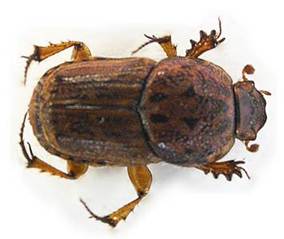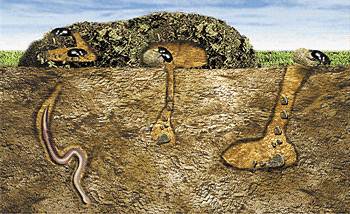- Dung beetles can be used to address soil structure problems, nutrient loss and
organic matter loss
- Try to work with the greatest number of species possible on your property
|
- Select parasite control chemicals, insecticides and other farm chemicals that do not
harm dung beetles
- A neighbourhood program will be more effective that individual farm approach
|
Understanding the question
|
| Why is it important to me as a farmer?
|
- Need to address soil-related problems in sub soils through the loss of:
- water retention capacity of soils
- soil nutrients
- organic matter
|
- In addition to these soil-related issues, famers need to reduce the negative impact of
cow manure on pastures which can result in large numbers of flies, parasites and an
increase in animal disease
|
| What do dung beetles do to your soils?
|
- Dung beetles develop tunnel systems that improve the physical structure of the soil
by:
- Increasing aeration
- Reducing compaction
- Bringing subsoils to the soil surface
- Incorporating organic matter into the soil profile
- They do this by constructing tunnels under a dung pad which can vary in depth from
<10 cm to up to 1m, depending on species and soil type
- The tunnels are often lined with dung and the beetles construct 'brood balls' from dung in which they lay their eggs
- Soil casts around dung pads are an indication of dung beetle activity
- In addition, the rapid removal of pats reduces fly breeding sites and therefore
reduces flies

Figure 1 - Dung beetle (Bubas bison) - Source: Soil Types and Structures Module, DEPI Victoria
|

Figure 2 - Earthworm and dung beetle tunnelling - Source: Soil Types and Structures Module, DEPI Victoria
|
Managing the use of dung beetles
|
| What is the best practice?
|
- Find out if you already have dung beetles on your farm
- Sample pads where you do have them
- Increase your dung beetle species
|
- Monitoring beetle activity
- Find out what dung beetles have already been introduced into your area
|
| How can you achieve this?
|
- How do I know if I already have dung beetles?
- There are some outward signs to look for also such as soil castes on a dung pad
and rapid disintegration of dung pads also suggests dung beetle activity
- How to sample pads
- Approached quickly and quietly since beetles are very sensitive to vibration and
will quickly bury themselves if they sense someone approaching
- Select pads that are 1-2 days old with cracks in the crust as these pads will be
old enough to have enabled beetles to establish
- Slide a spade or shovel under the dung pad where the dung meets the ground
- Take the entire dung pad with about two or three centimetres of soil from
underneath it
- Do this very quickly so that the beetles do not have a chance to escape
underground
- Transfer the dung and dirt to a clean bucket
- Place only one pad in each bucket to avoid overfilling
- Fill the buckets with water and stir well to break up the dung and soil
- Beetles will float to the surface
- Using a sieve pick these out
- Repeat the process of stirring and sieving until no more beetles are found
- While handling beetles be careful that they don't fly away!
- Increase your dung beetle species:
- You need a number of dung beetle species to get the most dung buried over the
longest possible period. Because each species is highly active for only a part of
the year, you need a variety of species that are active at different times of the
year
|
- Monitor beetle activity:
- By monitoring the dung beetle population on your farm you can determine if you are
having any impact, either positive or negative, on the local dung beetle population.
Remember though, that climate has a huge impact on dung beetle populations. Most
species are more active in warm moist conditions, so changes you see may relate to
climatic changes, not to anything you have done
- Introducing dung beetles:
- Dung beetles do not necessarily stay where they have been released. Beetles
released on your property could well fly to your neighbours' properties.
Consequently, it is often community groups, such as Landcare groups, which buy
dung beetle colonies and release them
- It is worthwhile knowing which dung beetle species are already present in the area if
you are considering introducing additional species - there is no point bringing in
more of a species which has already established itself in the area
- The Heytesbury District Landcare Network released 6 new species in 2008 to extend
beetle activity from summer through to winter. These were introduced in Curdievale,
Timboon, Simpson and Upper Curdies areas. There is currently no suitable species for
introduction for the spring period
|
Other related questions in the Brown Book
|
|
Brown Book content has been based on published information listed in the Resources and References sections below
|
- Johnston T (2011), Soil Types and Structures Module. Victorian Department of Primary
Industries.
- Dung Beetles. Landcare Online.
- Spence S. Dung Beetles - Working for you. Department of Primary Industries - NSW.
|
- Dung Beetle factsheet - June 2008. Heytesbury District Landcare Network.
- The pasture growth and environmental benefits of dung beetles to the southern
Australian cattle industry (2007). Meat and Livestock Australia (MLA).
|
|